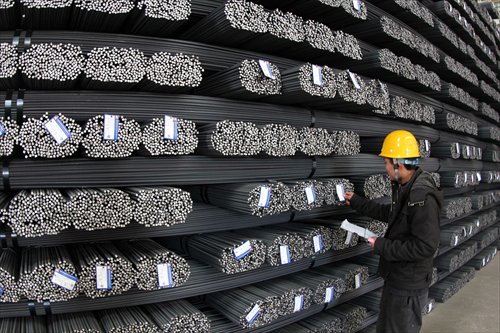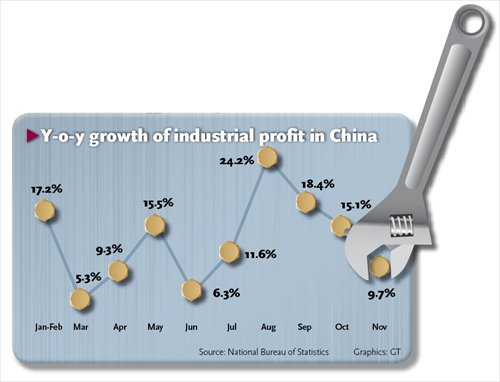HOME >> BUSINESS
Overcapacity still a problem: MIIT
By Zhang Ye Source:Global Times Published: 2013-12-30 23:23:01

A worker checks steel inventories Monday in Ganyu county, East China's Jiangsu Province. The province aims to cut steel production by 7 million tons over the next five years. Photo: IC

China's industrial enterprises still face the problem of overcapacity, the country's industry watchdog said Monday, noting that domestic demand will face downward pressure in 2014.
Since 2012, the overcapacity concern has started spreading from traditional industries - including iron, steel and chemicals - to emerging ones such as carbon fiber and solar power, and capacity utilization is less than 75 percent in some sectors, according to a report posted by the Ministry of Industry and Information Technology (MIIT) on Monday.
According to data from the National Bureau of Statistics, industrial companies saw their combined year-on-year profit growth slow for a third consecutive month to 9.7 percent in November.
The MIIT predicted that China's industrial output growth will be around 9.7 percent for 2013, down from last year's 10 percent.
Analysts said that overcapacity has become a threat to China's future development.
Authorities should encourage production of high-quality goods as well as cost-effective and energy-saving production lines, as this will help drive industrial consolidation and ease overcapacity, Zhou Hongchun, a researcher at the State Council's Development Research Center, told the Global Times Monday.
Based on guidelines issued by the State Council in October for resolving the country's overcapacity problem, the steel manufacturing industry is set to cut production over the next five years by 80 million tons.
According to media reports in late November, a total of 16 basic oxygen furnaces and 10 blast furnaces have been demolished in three cities in North China's Hebei Province, cutting 6.8 million tons of steel production capacity.
The government of Jiangsu Province announced Monday a plan to tackle its industrial overcapacity, pledging to cut steel production over the next five years by 7 million tons.
However, despite repeated warnings from the new leadership and a slew of measures by local governments, the overcapacity problem will remain in the next three years, Tian Yun, a scholar with the China Society of Macroeconomics, a government think tank, told the Global Times Monday.
In addition to overcapacity, domestic industry will continue suffering from feeble demand next year, said Tian.
Given the slow growth in exports as a result of the global economic downturn, domestic demand - mainly deriving from fixed-assets investment and domestic consumption - is expected to become a new driver for the country's industrial development.
However, Zhou said investment will be weaker in 2014, as once-strong sectors have lost their luster, and investors are still unsure about where will be the next destination for their money.
"People have noticed the bubble in the real estate sector, and infrastructure construction is slowing down amid tightened supervision over local government financing platforms," said Tian.
According to the MIIT's Monday report, total investment in newly begun industrial projects rose by 14.3 percent in the first 11 months, much lower than the rise of 28.8 percent in the same period last year.
The report forecast fast growth in domestic consumption of information products such as mobile devices, considering this sector a new engine to boost future economic growth, but slow growth in urban and rural incomes will weaken people's consumption ability to some extent.
Tian noted that consumption is unlikely to be strong in the following year in the wake of a nationwide anti-extravagance campaign initiated by the country's new leadership last December.
Posted in: Economy